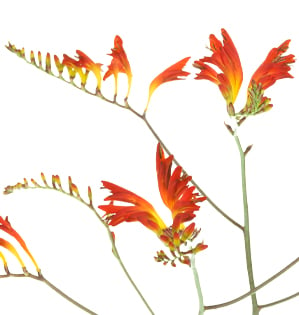Crocosmia - Montbretia

Common Names: Crocosmia, Montbretia, Coppertip
Botanical names: Crocosmia, (kro-KOS-mee-ah)
Availability: June through November
Vase life: 7 to 14 days
Storage temperatures: 36 - 38 degrees Fahrenheit
Ethylene Sensitive: Yes
Description: Trumpet-shaped blossoms on a long stem extending from spikelike foliage.
Color: Red, orange, yellow and shades
Botanical facts: The name is from the Greek word krokos for saffron and osme for smell. Dried crocosmia blossoms have the fragrance of saffron.
Design notes: Crocosmia is a wonderful line flower. Be aware that the blossoms may produce a colorless sticky sap which can drip.
Purchasing hints: Purchase when less than half of the blossoms have started to open.
Conditioning: Remove all foliage that will be below the water line. Cut two inches off of the stem endswith a sharp knife. Hydrate in a solution of water and commercial floral food for two hours before storage or usage.
Additional notes: Rich orange tube-shaped flowers pertly arranged around a central axis; little clusters of flowers that branch out into a typical freesia-like flower-spike - this architectural structure gives the Crocosmia a character of its own. Anyone with a good nose will also be able to make out the flower's modest, but highly specific saffron scent. The name crocosmia contains the Latin croceus (saffron-colored). The Crocus sativus is the source of our culinary saffron. Not only does the flower smell of saffron, but it has the spice's deep rich golden-tan color too. The flower's color is also reminiscent of its country of origin, South Africa, conjuring up sun-baked savannahs, dusty red roads, and warm sandy beaches. South Africa is also where the more common freesia, Gerbera and gladiolus originated. Perhaps crocosmia will become as familiar and as popular as these flowers. With their fiery yellow, orange, red and tan colors they will create a sparkling network of Indian summer lights in any bouquet.
Video Demonstration:

